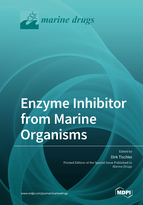Enzyme Inhibitor from Marine Organisms
A special issue of Marine Drugs (ISSN 1660-3397).
Deadline for manuscript submissions: closed (31 May 2020) | Viewed by 28072
Special Issue Editor
Interests: enzyme catalysis; oxidoreductases; secondary metabolites; biotransformation; enzyme mechanism and structure
Special Issues, Collections and Topics in MDPI journals
Special Issue Information
Dear Colleagues,
Marine habitats are promising sources to identify novel organisms and compounds. A total of 70% of the planet’s surface is covered by oceans, and little is known about the biosphere within these habitats. In the last few years, a number of original articles and reviews have reported on the potential of identifying novel bioactive compounds or secondary metabolites from marine environments. This is, and will be, a promising source for candidate compounds in pharma research and chemical biology. As in recent years, a number of novel techniques were introduced into the field and it has become easier to actually prospect for compounds, such as enzyme inhibitors. Those novel compounds than need to be characterized and evaluated in comparison to well-known representatives. This Special Issue focuses on the description of novel enzyme inhibitors of marine origin, including bioprospecting, omic approaches, structural and mechanistic aspects.
A number of current research projects target the exploitation of marine organisms and thus the corresponding diversity of metabolites. Those are often encountered as potential drugs or biological active compounds. Among those, the class of enzyme inhibitors is an important group of compounds. There is room for new discoveries and novel inhibitors and mechanisms are frequently reported. Thus, this Special Issue aims at collecting contributions from the field and providing a platform to make them more visible to the community.
Dr. Dirk Tischler
Guest Editor
Manuscript Submission Information
Manuscripts should be submitted online at www.mdpi.com by registering and logging in to this website. Once you are registered, click here to go to the submission form. Manuscripts can be submitted until the deadline. All submissions that pass pre-check are peer-reviewed. Accepted papers will be published continuously in the journal (as soon as accepted) and will be listed together on the special issue website. Research articles, review articles as well as short communications are invited. For planned papers, a title and short abstract (about 100 words) can be sent to the Editorial Office for announcement on this website.
Submitted manuscripts should not have been published previously, nor be under consideration for publication elsewhere (except conference proceedings papers). All manuscripts are thoroughly refereed through a single-blind peer-review process. A guide for authors and other relevant information for submission of manuscripts is available on the Instructions for Authors page. Marine Drugs is an international peer-reviewed open access monthly journal published by MDPI.
Please visit the Instructions for Authors page before submitting a manuscript. The Article Processing Charge (APC) for publication in this open access journal is 2900 CHF (Swiss Francs). Submitted papers should be well formatted and use good English. Authors may use MDPI's English editing service prior to publication or during author revisions.
Keywords
- Enzyme inhibitor
- Protein-ligand interaction
- Marine sponges
- Marine bacteria
- Secondary metabolites
- Metabolomics
- Chemical biology
- Bioprospecting







